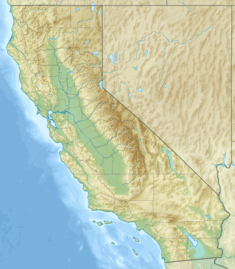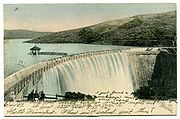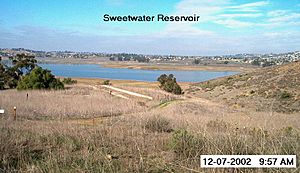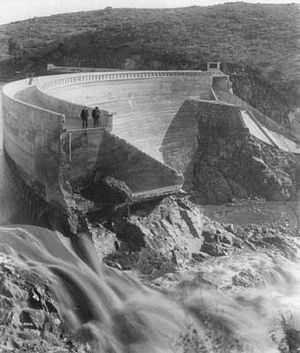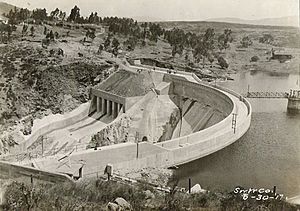Sweetwater Dam facts for kids
Quick facts for kids Sweetwater Dam |
|
|---|---|
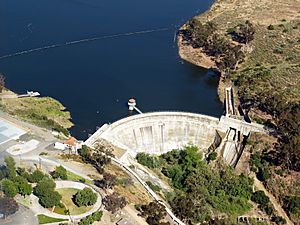
Sweetwater Dam and reservoir, May 2011
|
|
|
Location of the Sweetwater Dam in California
|
|
| Country | United States of America |
| Location | San Diego County, California |
| Coordinates | 32°41′29″N 117°00′29″W / 32.69139°N 117.00806°W |
| Status | In use |
| Construction began | 17 November 1886 |
| Opening date | 7 April 1888 |
| Construction cost | $234,074.11 |
| Dam and spillways | |
| Type of dam | Concrete gravity-arch |
| Impounds | Sweetwater River |
| Height | 108 ft (33 m) |
| Length | 700 ft (210 m) |
| Width (crest) | 25 ft (7.6 m) |
| Width (base) | 46 ft (14 m) |
| Spillway type | 7x gate-controlled, service + uncontrolled emergency spillway |
| Spillway capacity | 45,000 cu ft/s (1,300 m3/s) |
| Reservoir | |
| Creates | Sweetwater Reservoir |
| Total capacity | 28,079 acre⋅ft (34,635,000 m3) |
| Catchment area | 180 sq mi (470 km2) |
| Surface area | 960 acres (390 ha) |
| Power station | |
| Hydraulic head | 90 ft (27 m) |
| Installed capacity | None |
The Sweetwater Dam is a large dam built across the Sweetwater River in San Diego County, California. It is about 12 miles (19 km) east of San Diego. The dam creates the 960-acre (390 ha) Sweetwater Reservoir.
This dam was first built in 1888. It was part of a plan to store water for farms and towns in San Diego County. Over the years, the dam was made taller and stronger. In 1916, a huge flood damaged parts of the dam. But the main structure stayed strong. Today, the Sweetwater Dam is still used to control floods, store water, and for fun activities.
Contents
How the Sweetwater Dam Works
The Sweetwater Dam is a special type of dam called a concrete thick Arch-gravity dam. It holds back the Sweetwater River to form a large lake. This lake, the Sweetwater Reservoir, can hold 28,079 acre-feet (34,635,000 m3) of water.
The dam is 108 feet (33 m) tall and 700 feet (210 m) long. At its widest point, the base, it is 46 feet (14 m) thick. Water can be released from the reservoir through a special tunnel at the bottom of the dam. This helps control the water level.
Sometimes, there isn't much water flowing in the river below the dam. But when big floods happen, the dam is ready. It has two spillways with seven gates each. These can handle a lot of water, more than 45,000 cubic feet per second (1,300 m3/s).
The Sweetwater Dam works with another dam, the Loveland Dam, which is upstream. Together, they help control floods. The Sweetwater Dam also stores water for the San Diego area. It's like a backup water supply, especially during dry times. The reservoir is also a home for wildlife and a place for people to enjoy nature.
Building the Sweetwater Dam
Why a Dam Was Needed
San Diego has a nice climate, but it doesn't get much rain in the summer. Rivers can dry up, causing droughts. In winter, heavy rains can cause big floods. The ground in this area doesn't hold much groundwater. So, people needed a way to store water.
The Sweetwater River was one of the few rivers that flowed all year. But as more people moved to the area, the river alone wasn't enough. In 1869, a settler named Frank Kimball suggested building a dam. He saw a perfect spot where the river flowed through a narrow gorge.
The first plans for the dam were for a smaller structure. It would be 50 feet (15 m) high and hold 3,700 acre-feet (4,600,000 m3) of water. Construction began on November 17, 1886. Workers dug out a quarry nearby to get stones for the dam.
How the Dam Was Built
The San Diego Land and Town Company started building the dam's foundation. It was a large block of stone and cement, 36 feet (11 m) thick. The Sweetwater River was moved into a tunnel under the foundation. This kept the construction site dry.
As they built, engineers decided the dam needed to be stronger and taller. The plans changed. The dam's height was increased to 60 feet (18 m). Its base was made 26 feet (7.9 m) thicker. They even added special steps to the dam's sides. These steps would make it easier to make the dam even taller later.
The stones for the dam came from a quarry about 800 feet (240 m) away. The sand for the cement came from the river bottom. Both were perfect for building. When the dam reached 45 feet (14 m) high, they tested it for leaks. Water was held behind the dam, and it held perfectly.
Horses and mules pulled carts of stone from the quarry. At the dam site, tall cranes called derricks lifted the stones into place. Cement was also made right there. The dam was finished on April 7, 1888. It stood 90 feet (27 m) above its foundations. A spillway was built next to the dam to let out extra water.
Building the dam used a lot of materials. It cost $234,074.11. On April 19, 1888, over three thousand people came to celebrate. At that time, the Sweetwater Dam was the tallest masonry arch dam in the United States. It was seen as an amazing engineering feat.
Making the Dam Taller in 1911
In 1895, very heavy rains caused the Sweetwater River to flood. The dam's spillways couldn't handle all the water. For more than 40 hours, water flowed over the top of the dam. This damaged the sides of the dam, but the main part held strong.
To prevent this from happening again, work started in 1910. The dam was made taller, reaching 110 feet (34 m). A 20-foot (6.1 m)-tall wall was added to the top. The spillways were rebuilt, and the water intake tower was raised. This work finished in 1911. It allowed the reservoir to hold about 4,000 acre-feet (4,900,000 m3) more water.
The Big Flood of 1916
In 1915, Southern California was in a very bad drought. Reservoirs were almost empty. Farmers and ranchers were losing a lot. The city of San Diego even hired a man named Charles Hatfield, who claimed he could make it rain.
Starting on December 9, huge floods hit the county. It rained for over a month. Rivers and streams rose to record levels. Many bridges were washed away. Whole towns were flooded. Another dam, the Otay Dam, broke. This sent a huge wall of water into Chula Vista.
The Sweetwater River reached its highest flow on January 30, 1916. Even though the dam was taller, it couldn't hold all the water. The reservoir overflowed the dam by about 3.5 feet (1.1 m). The river broke through the earth on both sides of the dam. The main part of the dam was still strong. But two-thirds of the reservoir's water drained away.
The flood caused a lot of damage downstream. Pipelines, railway tracks, and power lines were destroyed. After the flood, the dam was rebuilt. An extra spillway was added to help handle future floods.
Recent Updates to the Dam
In 1939 and 1940, the dam got a big upgrade. The wall added in 1911 was lowered a bit. It was turned into an emergency spillway. This was because the two existing spillways were still not enough for very large floods.
The dam is now owned by the Sweetwater Authority. They manage the dam today. In the late 1900s, a new concrete layer was put on the dam. This was to stop any leaks. On April 7, 2006, the Sweetwater Dam was named a Historic Civil Engineering Landmark. This honor was given by the American Society of Civil Engineers.


